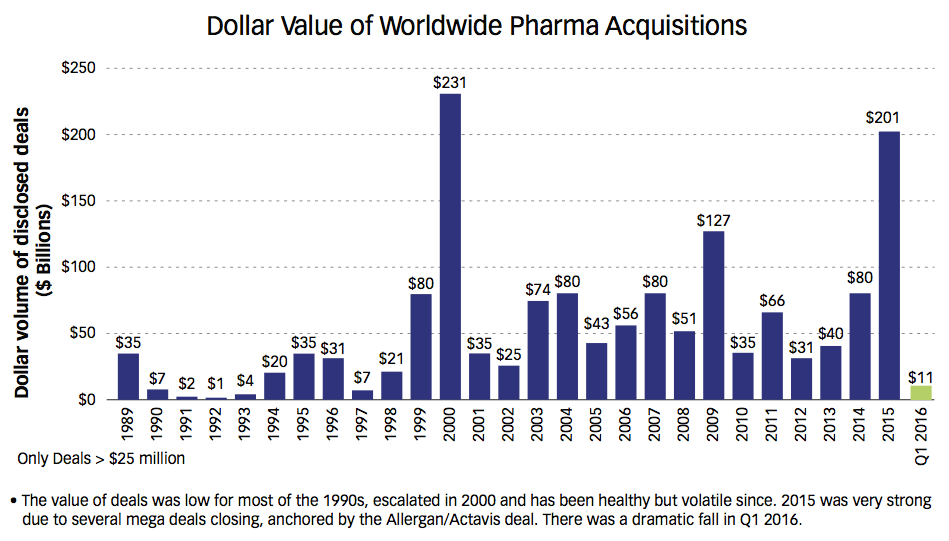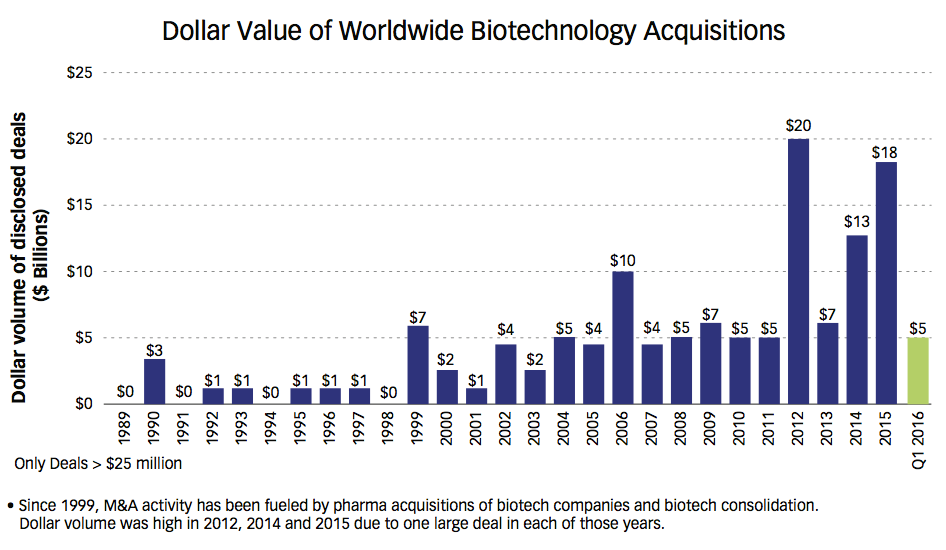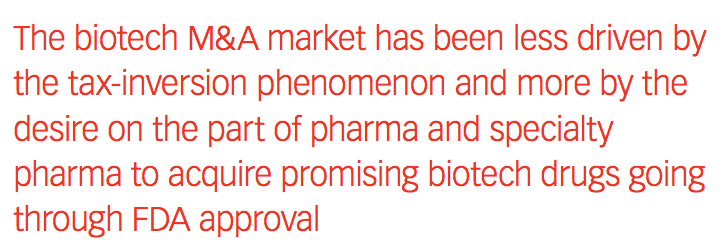Pharma and Biotech Financial Outlook: Hazy
Do recent trends in the pharma and biotech M&A and equity markets signal a temporary lull - or a permanent drop? Peter Young reports.
Do recent trends in the pharma and biotech M&A and equity markets signal a temporary lull - or a permanent drop?
The pharma and biotech industries are facing several structural factors specific to the sector itself, as well as external forces that are fostering uncertainty on overall global business and financial conditions. Political risks that could adversely impact investor perceptions about the viability of the industry’s long-term investment cycle are becoming more prominent, especially as the US begins a crucial presidential election season. Both major political parties are in the unprecedented position of challenging the industry’s historical business model based on the premise that high risk justifies high prices.
Valuations of pharma and biotech companies in the public and M&A markets soared up until August/September of last year because of positive industry developments, the search for high-growth potential products, and the restructuring activities of the industry. More recently there have been a number of setbacks in public trading valuations due to the volatile equity markets and the negative publicity about drug pricing and other factors affecting the M&A markets.
The volume of M&A activity and IPOs has fallen dramatically in the first quarter of this year. This raises two critical strategic questions for the biopharma “C-suite:” What caused this fall in volume and valuations? Is the current trend temporary, or is it going to be around for the long-term - even a permanent aspect of the financial landscape in a maturing business?
The Stock Market and IPOs
The overall stock market fell significantly in January and February, but staged a vigorous recovery in March. As a result, the first quarter of 2016 saw the S&P 500 up 2.3% from the beginning of the year and the FTSE 100 increased by 1.3%.
Unfortunately, the pharma and biotech industries did not do as well.
During that period, the valuations of public U.S. Pharma declined slightly, but the European ethical pharma, generic, and specialty pharma companies declined more dramatically, During the first quarter, the Young & Partners (Y&P) US Pharma index decreased by 0.5%, the Y&P European Pharma decreased by 7.9%, the Y&P Specialty Pharma index decreased by 11.6%, and the Y&P Generic Pharma index decreased by 11.3%.
The biotech industry fared even worse. The Y&P Large Cap Biotech, Y&P Mid Cap Biotech, and Y&P Small Cap Biotech indices decreased by 13.3%, 22.4%, and 21.2%, respectively, far worse than what happened to any of the Y&P pharma indices. On the other hand, we are not even close to the trough levels from a number of years ago.
Very negative sentiment about the biotech and pharma industry was a major cause, as the media published numerous stories about drug pricing, to the point where investors became concerned about government and regulatory changes that would harm the industry’s growth and profitability. This was accentuated by the traditional bashing that the drug industry tends to receive during presidential elections in the US, since the politicians find the pharma industry an easy target to blame for high healthcare costs.
Of course, it is also true that the biotech industry had reached highs in the equity markets that many observers felt were excessive and hyped. This made the biotech fall even steeper than it otherwise would have been, hence the bigger drop in biotech versus pharma stock

market prices and valuations.
On the equity financing side, secondary equity offerings and IPOs of biotech companies have been at all-time highs in recent years. Pharma secondary equity offerings have been steady and IPOs are much less common.
Pharma equity issuance in the first quarter of 2016 was $5.3 billion versus $32.7 billion for all of 2015, a significant decline on an annualized basis. There was only one pharmaceutical IPO in the first quarter of 2016--by Shield Therapeutics PLC, a specialty company based in the UK. It closed on Feb. 12 for $47 million.
Biotech equity issuance in the first quarter of 2016 fell more dramatically, with only 31 equity offerings worth $3.2 billion completed compared to 206 offerings worth $20 billion during 2015.
In terms of IPOs, in the first quarter of 2016, only six biotech IPOs were completed that raised a total of only $0.5 billion in new equity, well below 2015 levels when 61 biotech IPOs were completed totaling $5 billion.
Hence, it is fair to conclude that the equity market has turned cold for pharma and even more so for biotech.
Figures in $ billions

What factors will change the trajectory of the equity offering calendar and activity from the current subdued and selective market to a more robust one? First, the overall equity market will have to show a great deal of strength. There has already been a recovery of the overall equity markets that started in March and we expect that to continue. Second, the sentiment toward the biotech and pharma industries has to improve. We feel this will happen, but not until the US presidential elections are over, there is relief from the negative press about drug pricing, and certain industry structural challenges improve. It may take more than a year or two before we see these sentiments turn around. Continuation of the current innovation renaissance, exemplified by a high volume of FDA and European Medicines Agency (EMA) approvals, alone, will not be enough.
Meanwhile, good companies that have successful clinical trials and commercial successes will be able to go public or issue follow-on equity, but it will be selective and at valuations below the peak levels of 2014 and 2015. The market will also tend to favor certain areas of new development such as genome editing (CRISPR) and immunotherapy.
The M&A market
The drop in the M&A market volume has been even more dramatic in pharma and less severe in biotech.
In the first quarter of 2016, only 10 pharma deals were completed, worth $11 billion, versus 56 deals completed, worth $200 billion, during all of 2015. From an annualized point of view, this represents an astonishing decrease in the dollars and the number of deals.
There was only one large deal completed, the $5 billion acquisition of Dyax by Shire. The backlog of transactions has also fallen dramatically.
As of March 31, the value of the pharma deals announced but not closed was $91.4 billion (21 deals), so there are deals in the pipeline. Notable announced transactions include Teva’s $40.5 billion acquisition of Allergan’s generics business, Shire’s $36 billion acquisition of Baxalta, and Mylan’s $10 billion acquisition of Meda.
But the pipeline fell from $240.4 billion (16 deals) at the end of December, with the terminated Pfizer/Allergan deal constituting a large part of the drop. The high volume of pharma M&A in recent years has been driven by both strategic and financial factors. Drugmakers are acting as both buyers and sellers, forming strategic alliances, and swapping assets as well as they shore up their core businesses, exiting non-core units, buying to build or buying to cut costs, and using or seeking US tax inversion advantages. A few of these factors have weakened or are no longer viable practically.
Figures in $ billions

Historically, biotech M&A activity has almost always been modest compared to the pharma industry, with small spurts of activity from time to time. In 2015, there were 31 biotech M&A deals completed, worth $18.2 billion.
In the first quarter of 2016, there were seven biotech M&A deals completed, worth $5 billion. This represents an annualized pace that is slightly lower on a number-of-deals basis and slightly higher on a dollar basis.
But the biotech M&A backlog is very sparse. As of March 31, 2016, the value of deals announced but not closed was very modest at only $0.7 billion on three deals.
What has caused the drop? In the case of pharma M&A, a large factor was the US Treasury rule changes that make tax-inversion deals (singular and serial) much more difficult to do. Although many feel that the recent tax rule changes were aimed squarely at the Pfizer/Allergan deal, the structural changes will affect a wide variety of attempts at tax-inversion transactions. In addition, the strategy that many organizations have been using where they acquire companies, increase their product prices, and, in some cases, slash their R&D expenditures is now under attack as a result of the governmental scrutiny around drug pricing. Many of the larger deals have been based on one or more of these three strategies.
Valeant Pharmaceuticals is an example of a company that relied heavily on all three methods (tax inversions, price increases, and reductions in R&D) and is in serious trouble now as a result.
Figures in $ billions

What will the future bring? Pharma M&A and financing
Y&P believes that the pharma industry stock market performance and valuations will be steady at the current levels for some time, as the industry continues to show its ability to develop and commercialize new drugs. But real improvement in the outlook will be held back by the overhang from the negative drug pricing campaigns that will continue

to suppress industry economics and investor opinions.
Equity financing has been less important for pharma companies, so the continued movement sideways at a lower level will not be damaging to their market positioning.
On the M&A front, expect the disappearance of a large portion of the pharma M&A market that was driven by tax inversion and the strategy of buying companies and raising their product prices and/or cutting R&D.
Fortunately, there is enough activity that is driven by restructuring of portfolios, additions of revenues and product lines, and geographic expansions to keep the overall M&A activity at a healthy, but less frothy level.
What will the future bring? Biotech M&A and financing
The biotech story will be a bit different. The biotech industry stock market performance and valuations may improve, but not to the exuberant levels that were experienced for the last couple of years. Some of the underlying reasons will be similar to the pharma industry--the overhang from the pricing problems and the negative publicity. But the biotech industry has hit a valuation bubble that will be harder to recreate in the next few years.
As explained earlier, the equity financing market will continue to be available for companies that are showing good data and in areas that the market is excited about, but

valuations will continue to be subdued relative to the previous peak valuations until the negative sentiment about the industry subsides. This could take one or more years or even longer to change.
On the M&A front, we expect the biotech M&A market to rebound to higher, but still traditionally modest levels. The biotech M&A market has been less driven by the tax-inversion phenomenon and more by the desire on the part of pharma and specialty pharma to acquire promising biotech drugs going through FDA approval. Partnering will continue to be a non-M&A alternative to achieve these goals, but the weak equity issuance market for biotech companies (including IPOs) will make it harder for these firms to raise cash with high valued public shares. This will drive many of them to sell themselves to big Pharma earlier than they would have during the last couple of years.
Y&P believes that the current stock market, equity financing, and M&A markets are suppressed, but they will rebound, but not to the levels they were at last year and the year before. The entire sector depends heavily on reputational goodwill from key stakeholders, especially regulators and payers that hold the reins on granting market access to the numerous new products now coming out of industry labs. This is a historical reality that shows no signs of going away.
Peter Young is President and Managing Director of Young & Partners, an international investment bank serving the pharma, biotech, and chemical industries. He can be reached at pyoung@youngandpartners.com

Cell and Gene Therapy Check-in 2024
January 18th 2024Fran Gregory, VP of Emerging Therapies, Cardinal Health discusses her career, how both CAR-T therapies and personalization have been gaining momentum and what kind of progress we expect to see from them, some of the biggest hurdles facing their section of the industry, the importance of patient advocacy and so much more.